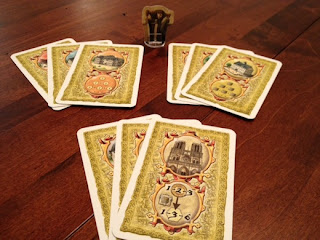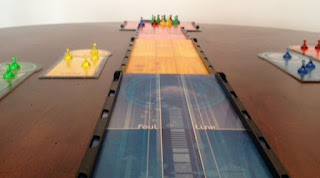A great little game that I bought by fluke last year is Notre Dame.
In Notre Dame, each player controls a section of the city, and they are attempting to help build the cathedral of Notre Dame - while avoiding being overrun by rats! The game consists of thee rounds, with each round having three turns. Each turn, a player will draw three of his nine cards and select one - passing the others to the player on his left. Then, from what is passed to him, he selects another one and passes. Finally, he accepts a third card. These cards represent actions that a player can perform, but he will only perform two of the three. These actions can allow you to remove rats, gain victory points, earn money, move your carriage, unlock more of your influence markers, and build Notre Dame. At the end of each turn, each player has the opportunity to hire a special helper, who can assist in moving your influence markers, gaining victory points, and dealing with rats. After this, rats frantically charge at the players, avoiding clubs, boots and gunfire on the way to bite your ankles, and anyone that is overrun with rats loses two victory points and an influence (perhaps I made that sound a bit more exciting than it really is). Finally, if the round is over (not just the turn), then players score victory points based on who assisted in Notre Dame and get their starting action cards back. At the end of the third round, the game is over!
The first thing that I enjoy about Notre Dame is the action card drafting. I have played a few games with a drafting mechanic in them, but I believe that Notre Dame does it at least as well as any other game I've played (including 7 Wonders). I really enjoy the fact that what actions you are able to perform are based on both what you draw and what other players pass to you. This forces you to adjust your strategy based on other players. For example, if you are passed a lot of carriage cards (I generally pass these), then it might be a good idea to go ahead and start implementing a carriage strategy. At the same time, you can look and see what the opponents on your left are doing, and you can decide to keep cards simply to prevent them from having them. (Though, this strategy obviously does not focus on earning your own victory points, and so it is less than ideal.)
 |
| The available action cards - and the Hunchback |
And, though your actions improve by doing them repeatedly, Notre Dame also forces you to do multiple different actions. How? Well, there are nine cards in each round, none of which repeat. And, you will be performing six actions each round. Even if you draft every copy of a given action, you will only be able to perform it three times - and so, you have to do something else, too. (Which is good, because I really don't think that you would have a chance at winning if you did any of the actions 18 times. Except for maybe the victory point action; but you would run out of influence that you could place on it!)
 |
| The board configuration changes based on number of players |
If I had to name a con for Notre Dame, it would be that there are not many special helpers (the cards that you hire at the end of the round). Each game, you will see all of them, and you will see six of them repeatedly in the same game. More of these would allow the game to have more variety from one play to the next. Yet, with that said, I think that the special helpers are well balanced, and the game gets a different feel based on who you play with and how they choose to draft cards each time, so this con is really very minor. (Also, the Notre Dame mini-expansion provides you with more of these.)
Overall, I give Notre Dame a 9.5/10. I love this game. It is easily one of my surprise favorite games, and has quickly jumped up to be one of my favorite "euro-style" games, on the same level as games like Puerto Rico.
If you like Notre Dame, you may also be interested in Biblios, Pillars of the Earth, and Le Havre.




















